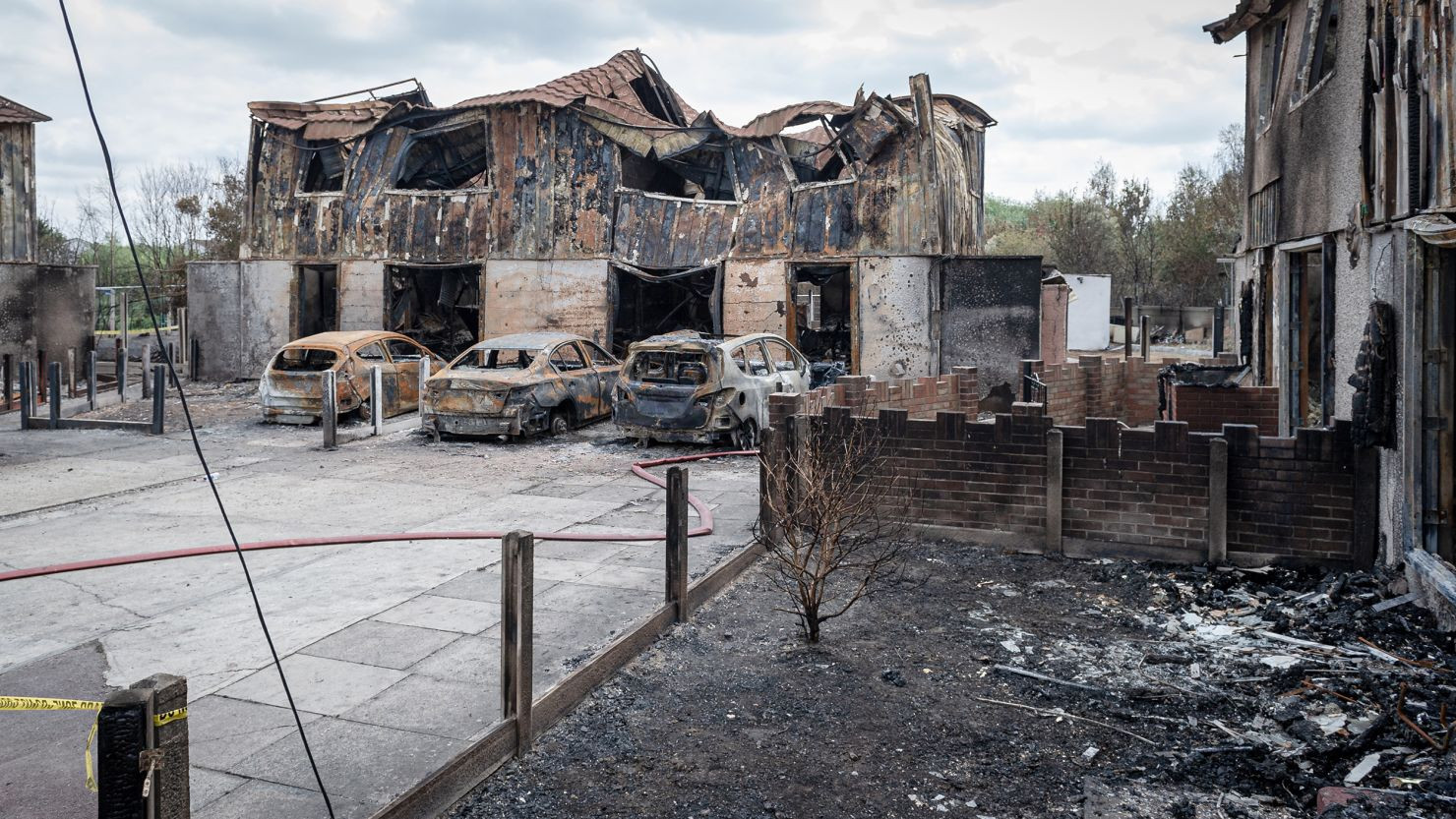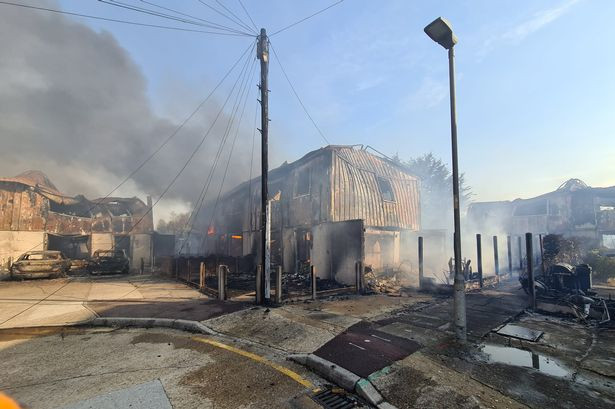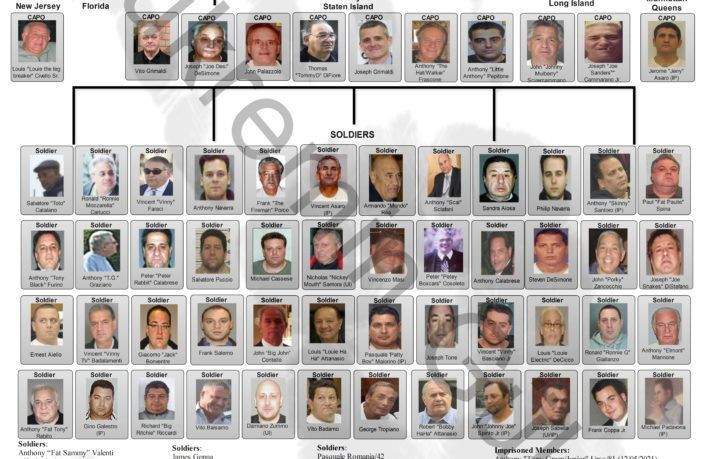A fire at a block of flats in Dagenham, east London, on Monday has sparked fresh debate about the slow progress of cladding remediation in the UK. James Riding runs through what we know so far.
More details are emerging about the fire that engulfed the Spectrum Building on Freshwater Road overnight on 26 August. We now know that the block had several fire safety issues and cladding remediation work was underway when the fire broke out.
It also appears that residents had highlighted their fears about wooden decking on balconies and “broken” fire doors as far back as 2018.
Forty fire engines and 225 firefighters tackled the blaze at the Spectrum Building. The whole block was affected by the fire, including scaffolding that had been surrounding the property and roof.
The fire brigade was called at 2:44am and the first crew arrived within five minutes. The fire, which was declared a major incident, was under control by 11.13am.
Everyone has been accounted for, with more than 80 people evacuated. Four people were treated on scene by ambulance crews and two people were taken to hospital.
London fire commissioner Andy Roe said the building has “a number of fire safety issues known to London Fire Brigade”. He added: “We will now begin a full investigation into the fire and its cause.
“This was a very dynamic and challenging incident, and we know there will undoubtedly be concerns around the fire safety issues present within the building and this will form part of our report.”
According to the Spectrum Building’s registration data with the Building Safety Regulator, the block is seven storeys above ground with a basement and 19.7m tall.
The i reported that the block of flats is an office-to-residential conversion. The property was originally the office of the American chemical company DuPont. The building was built in 1974 and converted to flats in the 2010s, with solar panels and a roof deck area added.
In 2017, planning permission was sought to add more flats on top of the block, with the new storeys supported by a timber frame. The application was refused, but then granted in 2018 following an appeal. The building now consists of 60 flats, as well as a communal roof terrace, two commercial units and a gym.
The developer of the building was Chadwell Properties and the current freeholder, Arinium, took over ownership of the block in January 2020.
The developer was warned about fire safety in the building.
According to The Times, emails filed by residents alongside the planning application to increase the number of flats showed they had raised concerns about fire safety with the block management company.
In February 2022, the Spectrum Building’s residents’ association submitted written evidence to parliament as part of the post-Grenfell safety legislation process. According to this evidence, roughly one-third of the flats in the block are owned by live-in leaseholders, with the rest occupied on a buy-to-let basis.
In its evidence to parliament, the residents’ association referenced a September 2020 external wall survey, which found the block did not fully meet building regulations at the time of construction.
The residents’ association warned that the “stress on leaseholders living in unsafe, unsellable flats with increasing service charges for well over three years is considerable”.
In April 2023, the London Fire Brigade issued an enforcement notice to Block Management UK, the management company for the building, urging it to review its fire risk assessment and emergency plan and implement preventative measures.
When the fire broke out, remediation work was underway to remove “non-compliant” cladding from the block, with scaffolding covering parts of the building.
Planning permission was granted in May 2023 for the removal of cladding on the fifth and sixth floors and its replacement with compliant cladding, as well as the removal of window spandrel panels and balcony privacy screens.
The work had been due to begin in June 2023 and finish in December, but last week cladding manufacturer Valcan wrote on Facebook that work to replace the cladding was ongoing.
Planning documents from April 2023 show how the cladding removal was designed to work. Non-compliant high pressure laminate Trespa cladding panels would be removed and replaced with new Valcan “Cerama” cladding panels, attached to the existing internal build-up.
Also, non-compliant spandrel panels would be removed and replaced with new Mettaline “Ultima” PPC aluminium-clad compliant panels.
The Grenfell United group of survivors and bereaved families said that the Dagenham fire was “a scenario we have warned about for seven years”.
It continued: “Although we do not have all the details, it seems work was underway to remove non-compliant cladding and the building had a number of fire safety issues.
“This highlights the painfully slow progress of remediation across the country and a lack of urgency for building safety as a whole, including the implementation of personal evacuation plans for disabled residents which needs urgently addressing.”
Adding that the Grenfell Inquiry Phase Two report is due in a week’s time, Grenfell United said “the fact that when a fire happens and the best we can hope for at the moment is ‘a near miss’, speaks volumes of the progress made since 14 June 2017”.
Deputy prime minister and housing secretary Angela Rayner said: “Our thoughts are with all those affected by the fire in Dagenham at this very difficult time.
“We are in close contact with the London Fire Brigade, council and other agencies on the ground to ensure those affected are being looked after.”
Margaret Mullane, Labour MP for Dagenham and Rainham, called for an investigation into why flammable cladding on the eight-storey building had taken so long to be removed.
She said: “We are seven years on from Grenfell and there is no reasonable excuse for unsafe cladding on residential blocks. Thankfully there was no loss of life, but 80 households have been displaced and serious questions must now be asked.”
Matt Wrack, general secretary at the Fire Brigades Union, said the blaze exposed the “national scandal of flammable cladding and deregulation in the building industry”. He said warnings about building safety had been “ignored by public authorities and by central government”.
The End Our Cladding Scandal campaign group said: “Being ‘in negotiations’ about remediation or having ‘plans in place’ counts for little when dangerous cladding – or other construction defects that enable fire to spread rapidly – remain on people’s homes.
“Today’s [Monday’s] incident demonstrates why action remains so urgent. Fire won’t wait while the legal and administrative battle rumbles on for years at each individual building.”
The Dagenham Fire: A Test for the Building Safety Regulator
The fire is a big test for the one-year-old Building Safety Regulator (BSR). “Since the BSR got their powers, there hasn’t been a major fire in a high-rise block,” says Matt Hodges-Long, chief executive of TrackMyRisks. “This is the canary in the coal mine. What do they do? Do they investigate, do they prosecute?”
He says the fire could prompt a debate about whether residents should be decanted from buildings while cladding remediation takes place. “Obviously it would cause a massive increase in cost, but can these remediations be done in a safe manner?”, he asks.
Questions Arising from the Fire
Other questions that must be asked in the coming days include:
- Why did it take so long to remove the flammable cladding? The Spectrum Building was the subject of an enforcement notice in April 2023, but the fire broke out before the cladding removal work was completed.
- Were there other fire safety issues in the building? The fire brigade has identified a number of fire safety issues in the building, including wooden decking on balconies and broken fire doors.
- What role did the developer and freeholder play? The developer, Chadwell Properties, was warned about fire safety in the building. The current freeholder, Arinium, took over ownership in January 2020.
- What is the impact on the residents? More than 80 people were evacuated from the building, and many have lost their belongings.
- How will the Building Safety Regulator respond? The BSR is tasked with ensuring the safety of buildings in England. The fire in Dagenham is a major test for the regulator.
Rayner Calls for Accelerated Cladding Remediation
Deputy PM visited Dagenham, east London, after fire tore through block of flats undergoing remedial works
Angela Rayner has called efforts to remove unsafe cladding from thousands of at-risk buildings “too slow” and said it was her job to ensure remaining works finished as quickly as possible.
The deputy prime minister made the comments during a visit to Dagenham, east London, on Tuesday afternoon, the day after a dramatic fire tore through a block of flats that was undergoing remedial works to remove “non-compliant” cladding.
More than 100 people were evacuated from the eight-storey building and two were taken to hospital. By Monday afternoon, the London fire brigade (LFB) said the blaze was under control and all residents were accounted for.
Taking place a week before the publication of the final report of the Grenfell Tower inquiry, the incident raised questions about the slow pace of remedial works on unsafe buildings since the 2017 tragedy.
Speaking to reporters while meeting residents in the area, Rayner said: “We have identified 4,630 buildings that do have the cladding on. Over 50% of them have already started the remediation work. This was one of those buildings that had started that but this is too slow for me. We need to hurry it up.”
Rayner said the incident must have been “incredibly triggering” for the survivors of the Grenfell Tower fire.
“They spent seven years fighting to make sure that these changes were put in place, and now it’s my job to ensure that that happens as quickly as possible. We can’t continue for another seven years. We’ve got to do this very quickly, because these are people’s homes, and people deserve to feel safe in their own home,” she said.
Calls by Rayner to speed up safety works came after Dame Judith Hackitt, who led a review on building safety after the Grenfell Tower fire, said the government needed to step up the pace of “remediation and holding those who are responsible to account for doing so”.
Speaking about the wider housing crisis, Rayner said: “We’ve had a shortage of housing and we haven’t built enough, but we also need to make sure that these homes are built with people in mind and remembering that these are places where people live and where they raise their families.
“They’re not assets that people can sweat and make money off. These are actually places where people need to live, and the number one issue for me is that people need to feel safe.”
The LFB said the Dagenham tower had known fire safety issues. The i newspaper reported that it was previously an office block that had been converted into flats.
A Second Fire in East London
About an hour after the Dagenham fire was declared under control, another blaze began in nearby Poplar. The LFB were called to the 44-storey Charrington Tower in the New Providence Wharf development at 1.28pm. The fire was under control by 2.50pm.
While that specific block has an EWS1 certificate, which proves wall materials are non-combustible, another block in the same development was ordered to remove its Grenfell-style cladding after a fire in 2021 trapped residents in their homes.
A Major Incident
Two people have been hospitalized after fire engulfed an apartment building in east London, forcing its evacuation and sending thick black smoke into the air
LONDON -- A fire engulfed an apartment building in east London early Monday, forcing its evacuation and sending two people to the hospital.
The London Fire Brigade said the fire was reported at 2:44 a.m. and the entire building was affected, including scaffolding surrounding the property and the roof.
The London Ambulance Service said four people were treated at the scene and two were taken to a hospital.
As many as 40 fire engines and about 225 firefighters responded to the fire at the building, which has both residential and commercial units. The cause of the blaze isn't yet known.
Shortly after midday, the London Fire Brigade announced that all residents of the building had been accounted for.
A Fire in Blackwall
A fire at a high rise building in Blackwall was started after someone was smoking in a flat, the London Fire Brigade (LFB) has revealed.
Around 70 firefighters tackled a flat fire on the 25th floor of the 45-storey building, which destroyed part of a flat and an entire balcony.
There were no reported injuries.
LFB said ten fire engines were scrambled to tackle the flat fire shortly before 1.30pm on Monday at New Providence Wharf, Biscayne Avenue.
The fire is being treated as accidental and firefighters believe it was caused by the unsafe disposal of smoking materials.
A Call for Caution
A Brigade spokesperson said: “If you smoke it is vitally important you stub it right out, preferably in an ashtray.
“Always ensure your cigarette is completely out when you’ve finished smoking it. If you don’t, you risk causing a fire as you don’t know what it may land on which could potentially start a fire.”
The LFB said the blaze had been brought under control by 2.50pm but it continued to produce a large amount of smoke.
Those in the local area were advised to keep windows and doors closed and avoid Biscayne Avenue, the LFB said.
Witness Account
Dylan Lee, 28, who saw flames and smoke billowing from the structure while he was in his apartment in Canary Wharf opposite, said he felt “dread” at the sight.
The designer and VFX artist told PA: “Around 13:25, an alarm rang out when I noticed smoke billowing from the apartment.
“Debris and pieces had fallen from the balcony, glass shattered and caused the fire to expand and engulf the space, with flames reaching out as the wind carried the smoke.”
He said the fire brigade arrived 20 minutes later and added: “I felt dread, especially considering this is the second apartment fire in 24 hours in East London alone.
“I’m hoping the residents made it out OK and the firefighters are in one piece. This was somebody’s home.”
The fire came just hours after firefighters tackled a huge fire at an apartment in Dagenham.
Twenty people were rescued and more than 80 people were evacuated from the building, which had ‘known’ fire safety issues


















